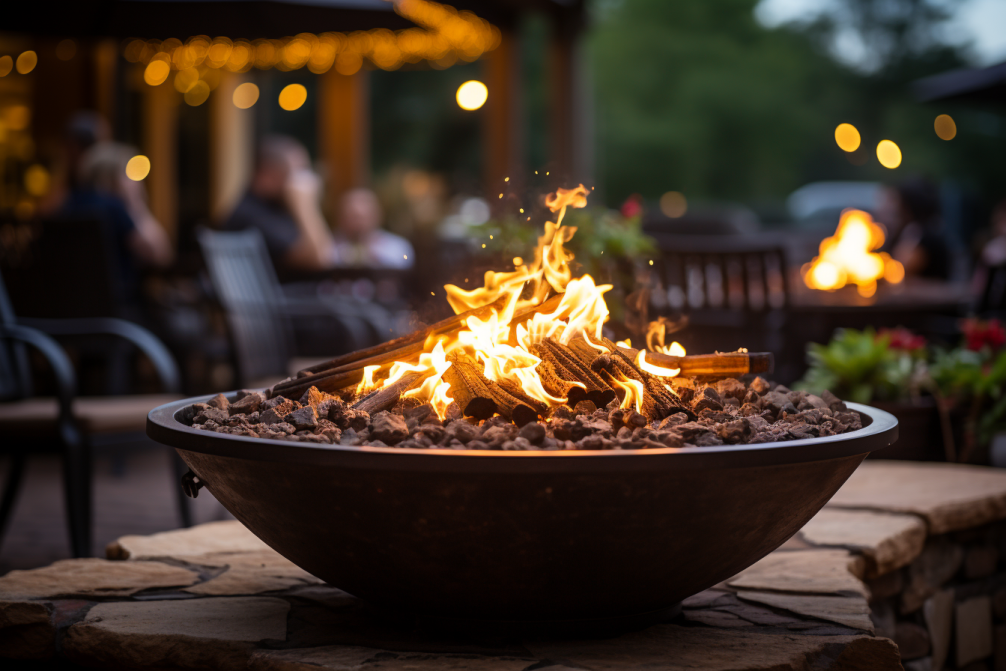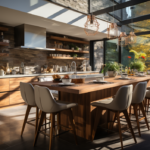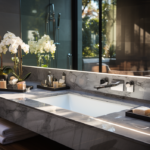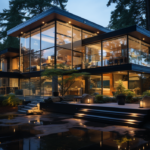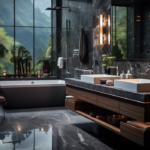Table of Contents
Transform Your Outdoor Space with a Stylish Fire Pit
Are you tired of having a boring, empty backyard? Want to create a warm and inviting atmosphere for those cozy summer nights under the stars? Look no further than building your very own fire pit! Not only will it add a touch of charm to your outdoor space, but it will also become the go-to spot for friends and family to gather around.
Building a fire pit might seem like a daunting task, but with the right materials and a little bit of effort, you can have a stylish and functional fire pit in no time. Imagine roasting marshmallows, sharing stories, and enjoying the crackling sound of the fire. It’s the perfect way to create lasting memories and foster a sense of togetherness.
One of the best things about building a fire pit is the flexibility it offers. You can customize it to match your own personal style and preferences. From sleek and modern designs to rustic and natural looks, the possibilities are endless. Additionally, you can choose the size and shape that best fits your backyard and desired seating arrangement.
Not only will a fire pit improve the overall aesthetic of your outdoor space, but it will also increase the value of your home. It’s a great investment that you can enjoy for years to come. So, roll up your sleeves, gather your materials, and get ready to transform your backyard into a cozy oasis with your very own fire pit.
Choose the Perfect Location
Finding the ideal location for your fire pit is crucial to ensure maximum enjoyment and safety. Here are a few essential aspects to consider when selecting the perfect spot for your backyard fire pit:
- Safety First: Safety should be your top priority when choosing a location for your fire pit. Make sure it’s away from any flammable materials, such as overhanging trees or bushes. Keep a safe distance from your house, fences, and any other structures. It’s also essential to check local regulations or homeowner association rules regarding fire pits to avoid any potential issues.
- Clearance: Ensure you have enough space for a comfortable seating area around the fire pit. The area should be clear of any obstacles like furniture, plants, or other objects that could pose a hazard or obstruct the view. Consider the wind direction and make sure there’s enough clearance to prevent any smoke from blowing towards your house or seating area.
- Level Ground: It’s vital to choose a spot on level ground to prevent any accidents or fire mishaps. A flat surface ensures stability for both the fire pit construction and the seating around it. Avoid any uneven or sloping surfaces that could cause the fire pit to be unstable.
- Accessibility: Think about how easily accessible the fire pit location is. You don’t want to place it too far from your house or outside entertaining areas. Also, consider convenience when it comes to transporting firewood or other supplies. Ideally, the fire pit should be in close proximity to minimize back-and-forth trips.
- Ambience: Lastly, think about the overall ambience and atmosphere you want to create in your backyard. Consider the view, landscaping, and how the fire pit will fit into the overall design. You may want to position it to take advantage of beautiful views, create a focal point, or integrate it into your existing seating or entertainment area.
Choosing the perfect location for your fire pit sets the stage for unforgettable gatherings, cozy evenings, and endless enjoyment in your outdoor space. Take the time to evaluate the various aspects mentioned above and find the best spot that satisfies safety, functionality, and aesthetic considerations.
Gather Your Materials and Tools
Before diving into the construction of your fire pit, it’s essential to gather all the necessary materials and tools. Here’s a list of the essentials you’ll need to bring your backyard fire pit project to life:
- Fire Pit Kit or Materials: Determine the type of fire pit you want to build. You can either opt for a fire pit kit that includes all the necessary components, such as a metal ring or stones, or gather the materials yourself. If you choose the latter, you’ll need bricks, pavers, concrete blocks, or natural stones to construct the fire pit walls.
- Gravel: A layer of gravel is crucial for proper drainage and stability. Ensure you have enough gravel to create a thin layer at the bottom of your fire pit or as needed according to the specific design you choose.
- Sand: Sand is necessary for leveling the ground and creating a sturdy base. It’s also useful for filling gaps between the stones or bricks, enhancing stability and preventing shifting.
- Shovel: A sturdy shovel will come in handy for digging the area, removing grass or vegetation, and leveling the ground. Opt for a shovel that provides a comfortable grip and can withstand the manual labor involved.
- Tape Measure: Accurate measurements are crucial for ensuring the fire pit is properly aligned and symmetrical. Use a tape measure to measure distances, dimensions, and levels throughout the construction process.
- Level: A level is essential for checking the evenness and alignment of the fire pit walls. This tool will help you achieve a balanced and sturdy structure.
- Rubber Mallet: A rubber mallet is useful for aligning and adjusting bricks or stones without causing damage. It allows you to tap pieces into place gently.
- Safety Gear: Don’t forget to prioritize safety by wearing gloves and safety glasses to protect your hands and eyes during the construction process.
By gathering these essential materials and tools, you’ll be well-equipped to tackle your fire pit project with confidence. Double-check the specifications of your chosen design to ensure you have all the necessary supplies before getting started. With everything at hand, you’ll have a smoother and more efficient construction process, bringing your backyard improvement project one step closer to completion.
Measure and Mark the Area
Before you start digging or constructing your fire pit, it’s crucial to measure and mark the area properly. Taking the time to do this step accurately will ensure that your fire pit is positioned correctly and that you have enough space for seating and enjoying the flames. Here’s how to measure and mark the area for your fire pit:
- Find the Center: Determine where you want the center of your fire pit to be. This will depend on the size of the fire pit and the overall layout of your backyard. Measure the diameter of the fire pit and divide it by two to find the radius.
- Mark the Radius: Using a tape measure, measure from the center point outward in all directions to mark the radius of the fire pit. Use a stake or a long piece of string tied to a stake to mark the outer edge of the fire pit.
- Measure Clearance: Consider the recommended clearance for your fire pit to ensure safety. Measure and mark the distance between the outer edge of the fire pit and any surrounding structures, such as your house, trees, or fences.
- Mark Seating Area: If you plan to have seating around your fire pit, measure and mark the area where you want the seating to be. Keep in mind that you’ll want enough space for comfortable seating while still being close enough to enjoy the warmth of the fire.
- Double-Check Alignment: Use a level or a long piece of string to connect the marked points and ensure that the fire pit is properly aligned and symmetrical.
By taking the time to measure and mark the area correctly, you’ll lay the foundation for a well-positioned fire pit that maximizes both safety and enjoyment. Double-check your measurements and alignment to avoid future issues. Once you’ve completed this essential step, you’re ready to move on to the next exciting phase of building your fire pit.
Clear the Space and Prepare the Foundation
Before you start building your fire pit, it’s essential to clear the space and prepare a solid foundation. This will ensure that your fire pit is stable, level, and safe. Follow these steps to clear the space and prepare the foundation for your backyard fire pit:
- Remove Debris: Clear the area of any debris, such as rocks, sticks, leaves, or vegetation. This will provide a clean and level surface for your fire pit.
- Mark the Perimeter: Use stakes and string to mark the perimeter of your fire pit. This will help guide your digging and ensure that you stay within the designated area.
- Dig the Area: Dig a shallow hole within the marked perimeter. The depth will depend on the type of fire pit you’re building and the recommendations provided by the manufacturer or your specific design. Remove any excess soil or turf and set it aside for later use.
- Create a Sub-base: Create a sub-base by adding a layer of gravel to the bottom of the hole. This will help with drainage and prevent the formation of puddles or water accumulation.
- Compact the Gravel: Use a tamper or a hand compactor to compact the gravel layer. This will provide a stable base for the fire pit.
- Add Sand: Pour a layer of sand over the compacted gravel. The sand will help to further level the surface and provide a cushioning effect for the fire pit materials.
- Level the Sand: Use a board or a flat tool to level the sand, ensuring an even surface for constructing the fire pit.
Once you’ve cleared the space and prepared the foundation, you’ll have a solid base to construct your fire pit. The cleared area and properly prepared foundation will contribute to the stability and longevity of your fire pit, ensuring a safe and enjoyable backyard improvement project. Now you’re ready to move on to the next steps in building your dream fire pit!
Build the Fire Pit Structure
Now that you’ve cleared the space and prepared the foundation, it’s time to start building the structure of your fire pit. Whether you’re using a fire pit kit or constructing it from scratch, follow these essential steps to create a sturdy and beautiful fire pit:
- Lay the First Layer: Depending on your chosen design, begin by placing the first layer of bricks, pavers, or stones around the perimeter of the fire pit. Make sure they are level and snugly fit together.
- Continue Building: Stack additional layers of bricks, pavers, or stones on top of the first layer. It’s important to stagger the joints, similar to how you would build a wall, to ensure stability and strength.
- Check for Level: Use a level to verify that each layer is level and adjust if necessary. This will ensure a balanced and visually appealing fire pit.
- Use Adhesive: If you’re using bricks, pavers, or stones that require adhesive for extra stability, apply the adhesive between the layers as per the manufacturer’s instructions. This will add strength to the structure and help bond the pieces together.
- Fill Gaps: As you build, make sure to fill any gaps between the bricks, pavers, or stones with sand. This will enhance stability and prevent any shifting or movement.
- Create a Fire Ring: If your fire pit design includes a metal fire ring, position it on top of the structure. Ensure that it fits securely and sits level.
- Finishing Touches: Once the structure is complete, step back and admire your work. Make any necessary adjustments to the alignment or levelness. Consider adding decorative elements, such as capstones or a heat-resistant paint finish, to enhance the visual appeal of your fire pit.
By following these steps, you’ll create a durable and attractive fire pit that will bring warmth and joy to your backyard gatherings. Take your time, pay attention to detail, and enjoy the process of building your very own fire pit. With the structure complete, you’re one step closer to enjoying magical evenings around the flickering flames.
Install the Fire Pit Liner or Insert
With the structure of your fire pit complete, it’s time to install the fire pit liner or insert. This step is essential to protect the interior of the fire pit and ensure efficient burning. Follow these steps to install the fire pit liner or insert:
- Choose the Right Liner or Insert: Consider the type of fuel you’ll be using (wood, gas, or propane) and choose a liner or insert that is compatible with your preferred fuel type. Fire pit liners can be made of stainless steel, cast iron, or other heat-resistant materials.
- Place the Liner or Insert: Carefully position the liner or insert inside the fire pit structure, ensuring that it is placed securely and centered.
- Check for Proper Fit: Verify that the liner or insert fits snugly within the structure. There should be minimal gaps between the liner and the walls of the fire pit.
- Adjust as Needed: If the liner or insert doesn’t fit perfectly, make any necessary adjustments to ensure a proper fit. This may involve adding or removing sand or gravel as a base underneath the liner.
- Connect Gas or Propane Lines (if applicable): If you’re using a gas or propane fire pit, follow the manufacturer’s instructions to connect the gas or propane lines to the appropriate ports on the liner or insert.
- Secure the Liner or Insert: Depending on the design, there may be screws, bolts, or brackets provided to secure the liner or insert within the fire pit structure. Make sure to use the specified fasteners and tighten them securely.
- Test for Stability: Once the liner or insert is installed, give it a gentle shake to ensure that it is stable and securely in place.
By installing the fire pit liner or insert, you’ll add an extra layer of protection and create a functional and efficient burning space for your fire pit. Take your time to ensure a proper fit and consult the manufacturer’s instructions for any additional steps or precautions specific to your chosen liner or insert. With the installation complete, you’re one step closer to enjoying cozy evenings around your newly built fire pit.
No products found.
Add the Finishing Touches: Choose a Fire Pit Cover or Screen
To fully complete your backyard fire pit project, it’s important to add the finishing touches that will enhance both the functionality and appearance of your fire pit. One essential element to consider is choosing a fire pit cover or screen. Here are some key points to guide you in making this important decision:
- Protection: A fire pit cover or screen serves as a protective barrier, preventing debris, leaves, and rainwater from entering the fire pit when it’s not in use. It also helps to prevent sparks or embers from escaping, reducing the risk of accidental fires.
- Material: Fire pit covers and screens can be made from various materials, including stainless steel, aluminum, or durable fabric. Consider the climate in your area and choose a material that can withstand weather conditions, such as rust-resistant stainless steel.
- Design: Fire pit covers and screens come in different designs and styles, ranging from simple and functional to intricate and decorative. Consider the overall aesthetic of your backyard and choose a cover or screen that complements your outdoor space.
- Size and Fit: Ensure that the cover or screen you select fits your fire pit properly. Measure the diameter or dimensions of your fire pit and choose a cover or screen that matches those measurements. A well-fitting cover or screen will provide optimal protection and a clean look.
- Custom Features: Some fire pit covers and screens offer custom features, such as built-in handles, vents for airflow, or spark guards. These features can enhance the usability and safety of your fire pit.
- Maintenance: Consider the ease of maintenance when choosing a cover or screen. Look for options that are easy to clean and maintain, ensuring longevity and a hassle-free experience.
Selecting a fire pit cover or screen is a crucial step in maintaining your fire pit and ensuring long-term enjoyment. Consider the protective function, material, design, size, custom features, and ease of maintenance when making your decision. By adding the perfect cover or screen, you’ll not only enhance the functionality of your fire pit but also add a touch of style to your outdoor space.
No products found.
Conclusion
In conclusion, building a fire pit can be an incredible backyard improvement project that transforms your outdoor space into a cozy gathering spot for friends and family. From the warmth of the flickering flames to the delightful aroma of roasted marshmallows, a fire pit adds a touch of magic and creates lasting memories.
By following the essential steps outlined in this article, including choosing the perfect location, gathering the necessary materials, measuring and marking the area, clearing the space, constructing the fire pit, installing the liner or insert, and adding the finishing touches, you’ll be well on your way to creating a stunning fire pit that not only enhances the aesthetic appeal but also offers a safe and enjoyable experience.
Remember to prioritize safety throughout the entire process and comply with any local regulations or homeowner association guidelines. Additionally, don’t forget to consider the design and style that best suits your outdoor space, whether it’s a sleek modern look or a rustic natural charm.
So, gather your materials, roll up your sleeves, and embark on this exciting backyard improvement project. Get ready to enjoy countless evenings of warmth, laughter, and connection around your own beautifully crafted fire pit. It’s time to create an outdoor oasis that will be the envy of all your neighbors!

